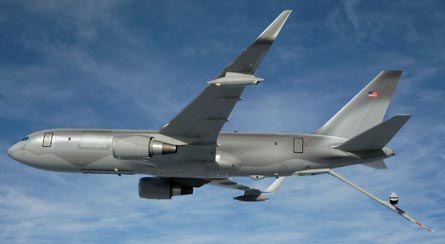In a huddle with reporters after a press briefing, a Boeing executive offered the most tangible hint to date that the KC-767 NewGen Tanker blends major structural components from different aircraft models.
Charles Johnson, Boeing vice president of air force mobility, told reporters during the briefing that it will not be "easy" for EADS North America to adapt the KC-45 with cockpit armour and defensive systems.
Asked afterward if Boeing could reassure the public that the KC-767 NewGen Tanker would require less challenging design changes, Johnson said he could.
 |
|---|
©Boeing |
A reporter noted that Boeing's KC-767 design featured a wing and fuselage from different aircraft models, which would seem to pose a greater redesign challenge than integrating defensive systems and cockpit armour.
Johnson replied that "it's pretty straightforward actually" to install a wing from a different model on to the 767-200 fuselage.
Johnson cited the example of the Boeing P-8A programme, which matches the wing of the 737-900ER to the fuselage of the -800 and is built in-line rather than modified afterward.
That was the closest Boeing has come to revealing details of the structural design of the KC-767 NewGen Tanker. In the last round of the KC-X competition, Boeing faced criticism for blending elements of three different 767 models into the so-called "frankentanker".
A day earlier, Boeing executives at a media roundtable pointedly declined to link the experience on the P-8A programme to the NewGen Tanker design, saying that doing so would be giving away competitive information.
Instead, Dennis Muilenburg, offered only one other key detail about the NewGen Tanker.
In response to questions, Muilenburg revealed the KC-767 NewGen Tanker includes a boom based on the hardware of the KC-10 and upgraded with fly-by-wire controls developed for the KC-767s purchased by Italy and Japan.
Boeing had previously indicated the system includes fly-by-wire, but had not disclosed the system for KC-X came from the Italian and Japanese tankers.
It seems a small detail, but it's one of the few specific disclosures that Boeing has allowed to be released in the intense competition for a contract award to build up to 179 tankers.
- All the latest news, video and images from the 2010 Farnborough air show - New this year, live streaming video of each day's flying display
Source: Flight Daily News



















